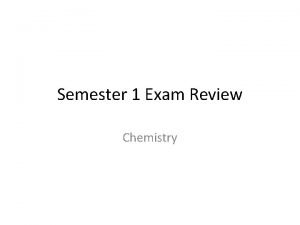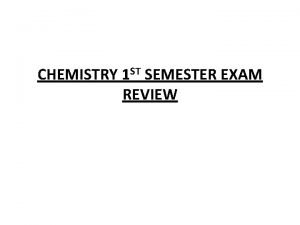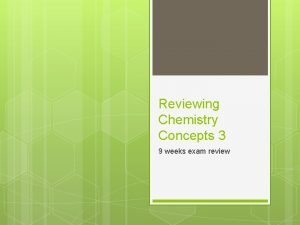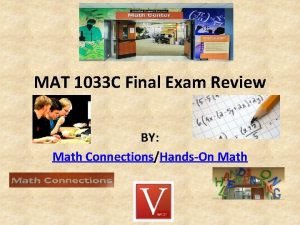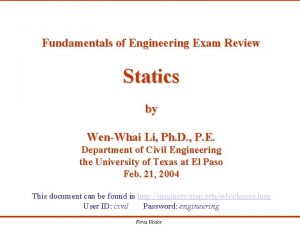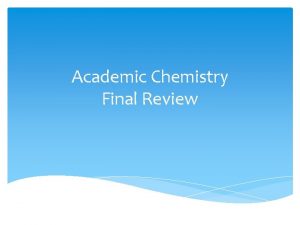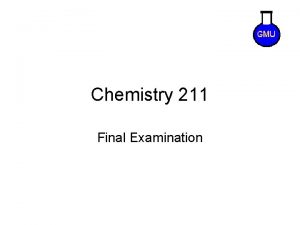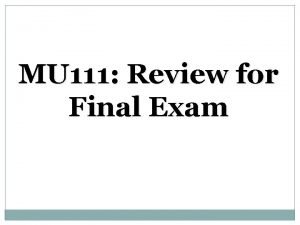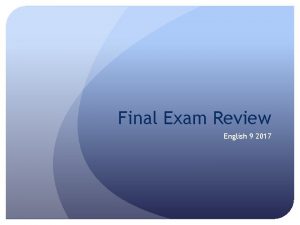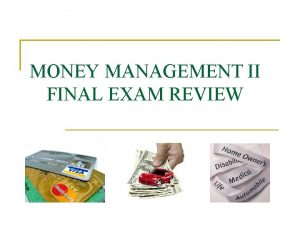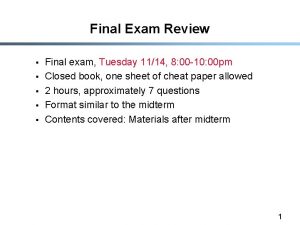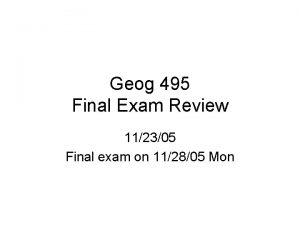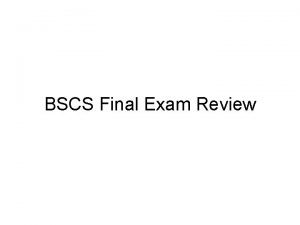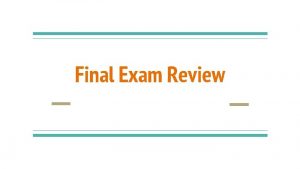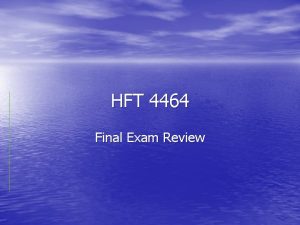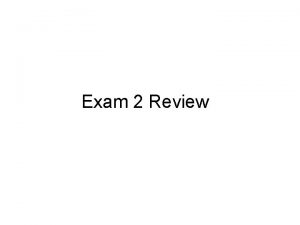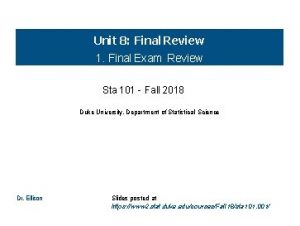Academic Chemistry Final Review Final Exam 51 Multiple






















- Slides: 22

Academic Chemistry Final Review

Final Exam 51 Multiple Choice Periodic Trends – definition Atomic/Ionic Radius, Electronegativity, ionization energy, electron affinity Accuracy/Precision General Equations Valence Electrons Octet Types of Energy metals/nonmetals/metalloids Pure substances – elements/compounds Mixtures – homogeneous/heterogeneous

Final Exam 51 Multiple Choice Balanced Equations Stoichiometry Polarity – bond & molecule (s), (l), (g), (aq) VSEPR anion/cation empirical/molecular formulas Heisenburg/De. Broglie/Hund/ Temperature scales based on family names

Final Exam 51 Multiple Choice covalent/ionic Rutherford frequency/wavelength/amplitude Effect of changes on gases Gas pressure parts of the scientific method separation methods alpha/beta/gamma electrons on a sublevel indicators of a chemical change

Final Exam 51 Multiple Choice conservation of mass/energy significant figures physical/chemical changes periodic table arrangement limiting reactant molar mass atom/molecule/formula unit protons/neutrons/electrons Thompson

Final Exam 9 problems limiting reactant problem empirical and molecular formula write a balanced formula & determine type Differences between solids/liquids/gases % yield density atom/ion/isotope ideal gas law names/formulas

Books must be turned in before you leave! You may turn them in during class any day this week!

Review Chapters 1 -4 1. 68. 59 m = 4 s. f. 2. 0. 0003050 = 4 s. f 3. Steps 1. Identify the problem or question 2. Gather information and observations 3. Form a hypothesis 4. Test the hypothesis 5. Analyze the data and form a conclusion 4. hypothesis – educated guess about a problem theory – tested hypothesis law – tested many times, scientific community believes it to be true.

Review Chapters 1 -4 5. 6. 7. 23°C + 273 = 296 K 8. °C = (62 -32) °C=16. 7°C+273 = 289. 7 K 9. Kinetic – motion (rolling ball) Potential – above ground level (boulder on a cliff) Radiant – light (sun) 10. Mass – amount of material Weight – gravity’s effect on the mass

Review Chapters 1 -4 11. a. element – atom b. Covalent - molecule c. Ionic – Formula Unit 15. Aufbau Principle – Electrons are added one at a time to the lowest energy level available. Pauli Exclusion Principle – An orbital can hold a maximum 12. Mendeleev of 2 electrons. These electrons must have opposite 13. Protons = 92 spins (clockwise & counter. Neutrons (233 -92) = 141 clockwise). Electrons = 92 Hund’s Rule – Electrons fill orbitals so that a maximum 14. Mass of Carbon - 12 number of unpaired electrons exist. (Ladies first!)

Review Chapters 1 -4 16. 1 s 22 p 63 s 23 p 64 s 23 d 104 p 6 5 s 24 d 105 p 66 s 24 f 145 d 9 17. [Xe]6 s 24 f 7 18. Ion – different # of electrons giving overall charge Isotope – different # of neutrons (different mass) 19. a. Dalton – Dalton’s atomic theory (from ideas of Democritus) b. Thomson – Cathode Ray Tube experiments c. Rutherford – Gold Foil Experiment 20. electron < proton = neutron < nucleus

Metals Non-Metals 1. “d” “s” Noble gases =metaloid (semi-metal) halogens Alkaline earth metals Alkali metals Review Chapters 5 -9 Transition Metals “p” “f” Inner Transition Metals

Review Chapters 5 -9 2. a. Cl-1 d. Al+3 b. Na+1 e. N-3 c. Mg+2 f. S-2 3. An octet 4. Ionic – metal/non-metal Covalent – 2 non-metals 5. Valence Shell Electron Pair Repulsion Theory 6. Polar – unequal sharing of electrons – causing partial positive and partial negative determine by difference in electronegativity

Review Chapters 5 -9 7. Base geometry - linear Shape – linear Non-polar Base geometry – tetrahedral Shape – Bent Polar Base geometry – tetrahedral Shape – tetrahedral Polar

Review Chapters 5 -9 8. a. sulfate b. ammonium 9. a. synthesis b. single replacement c. combustion c. phosphate d. carbonate d. decomposition e. double replacement 10. A molecule that exists in nature as two atoms bonded together. Br I N Cl H O F 11. light/heat. Precipitate. Gas. Color change.

Review Chapters 5 -9 12. 3 Mg. Cl 2 + Al 2(SO 4)3 3 Mg. SO 4 + 2 Al. Cl 3 13. a. barium hydroxide b. iron (III) chloride c. dinitrogen monoxide 14. a. NH 4 F b. Ca. SO 4 c. Mg 3(PO 4)2 d. Ammonium hydroxide e. Lead(II) sulfate f. Copper (I) sulfide d. Na 2 CO 3 e. Fe. SO 3 f. Cr 3 P 2 15. 2 C 2 H 6 + 7 O 2 4 CO 2 + 6 H 2 O

Review Chapters 10 -13 1. a. 40. 0 g b. 342 g c. 183. 4 g d. 149. 0 g 2. Empirical = lowest ratio Molecular = actual ratios 3. No, we cancel in criss cross to get lowest ratio 4. 6. 02 x 1023 - number of particles in a mole

Review Chapters 10 -13 5. 6. Standard Temperature and Pressure 0°C and 1 atm

Review Chapters 10 -13 7. Na – 23. o x 3 = 69. 0 /164. 0 x 100 = 42. 1% P – 31. 0 x 1 = 31. 0 /164. 0 x 100 = 18. 9% O – 16. 0 x 4 = 64. 0 /164. 0 x 100 = 39. 0% 164. 0 8.

Review Chapters 10 -13 9. 10. 11.

Review Chapters 10 -13 12. Exo – releases heat Endo – absorbs heat 13. Enthalpy change – tells us how much heat is gained or lost during a reaction 14. The amount of heat needed to raise the temperature of 1 gram of a substance 1 degree C q= m. C∆T

Review Chapters 10 -13 15. a. P 1 V 1 = P 2 V 2 b. T 1 V 2 = T 2 V 1 c. d. P 1 V 1 T 2 = P 2 V 2 T 1 e. PT = P 1 + P 2 + P 3… f. PV = n. RT P = pressure, V = volume, T = temperature, n = moles, R = ideal gas constant (0. 0821 g atm/ mol K) 16. The movement of one gas through another 17.
 Uncontrollable spending ap gov
Uncontrollable spending ap gov Accounting final review
Accounting final review Chemistry 151 final exam
Chemistry 151 final exam Chemistry
Chemistry Us history semester 1 final exam study guide answers
Us history semester 1 final exam study guide answers Chemistry semester exam review
Chemistry semester exam review 3rd 9 weeks exam review chemistry
3rd 9 weeks exam review chemistry World history spring final exam review answers
World history spring final exam review answers Spanish 1 final exam review packet answer key
Spanish 1 final exam review packet answer key Pltw human body systems final exam review
Pltw human body systems final exam review Poe final review
Poe final review Ied final exam review
Ied final exam review Us history semester exam review answers
Us history semester exam review answers Entrepreneurship 1 final exam review
Entrepreneurship 1 final exam review Spanish 2 review packet
Spanish 2 review packet Environmental science final review
Environmental science final review World history final exam study guide
World history final exam study guide American history semester 2 final exam
American history semester 2 final exam English 3 semester exam
English 3 semester exam Physics 20 final exam practice
Physics 20 final exam practice Physical science final exam review
Physical science final exam review Mat 1033 final exam review
Mat 1033 final exam review Fe exam statics review
Fe exam statics review



